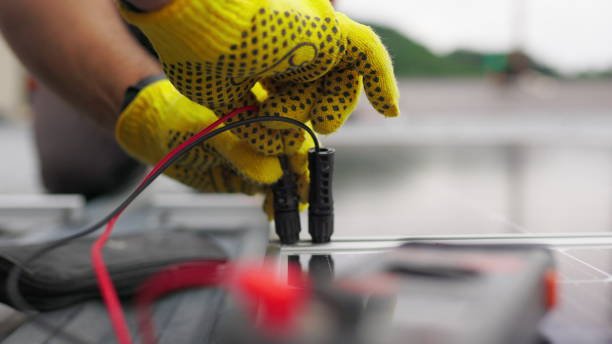Wondering if your solar panels are working optimally? Testing solar panels with a multimeter is more than just a technical task; it’s the pathway to help your solar system function at its peak. What if you could digitally diagnose your solar health from home with a simple tool? Regularly testing your panels not only aids in maximizing your system’s output but protects an investment you’ve made in sustainable energy. Environmental factors, such as dust, debris, and shading, may hinder the efficiency of your panels. Knowing how to test the panels using a multimeter enables you to spot trouble before it becomes a more significant issue
This guide will show you how to test solar panels with a multimeter. Whether you’re already a solar user or a homeowner curious to start exploring the world of renewable energy maintenance, this guide aims to be relevant, practical, and bursting with valuable insights. We welcome you to the wonderful world of solar panel diagnostics.
Why Test Your Solar Panels?
Solar panels convert sunlight into electricity using photovoltaic (PV) cells; several factors can impact their efficiency over time. Dust, debris, or even slight damage can also reduce energy output. Testing regularly is essential for multiple reasons. Monitor your voltage and current output to ensure your panels are working properly . A slight drop in performance means your energy during runs is going to waste. Routine testing helps catch issues like loose connections, cell degradation, or obstructions in the environment before they become serious problems. Keeping your solar panels clean is an essential aspect of maintenance. You reduce your energy costs and increase your ROI to make sure the system runs efficiently. Testing your solar photovoltaic systems is a key component of an ongoing preventative maintenance plan. A multimeter lets you obtain critical information about your system’s health without calling out a professional whenever you suspect a problem.
Workings of Solar Panels
Before diving into the testing procedures for solar panels, let’s take a step back into their components and the characteristics that define their electrical performance. This background will facilitate proper testing and interpretation of results.
Photovoltaic Cells: Solar Panel Building Blocks
Photovoltaic (PV) cells are the unsung heroes of every solar panel. These cells are semiconductor devices that use the photovoltaic effect to convert sunlight directly into direct current (DC) electricity. When photons from sunlight collide with the PV cells, electrons are knocked free from atoms in the semiconductor material, creating a flow of electricity. We connect many PV cells inside a panel to create an appropriate voltage level, and this is how a PV panel works.
Key Electrical Parameters
To determine how well a solar panel is working, you should know all the electrical parameters of a solar cell.
Open-Circuit Voltage (Voc):
VOC stands for the open-circuit voltage of a solar panel; when there is no load, it is open circuit. It indicates the pd between the positive and negative terminals under open-circuit conditions. The Voc of a solar panel is helpful as it means the maximum voltage of the panel under AM1.5 or standard test condition (STC) of 25°C cell temperature, 1000W/m² light intensity, and an atmospheric density of 1.5. Optimizing panel operation within safe voltage limits is a critical system design parameter.
Short-Circuit Current (Isc):
Isc is the current when the positive and negative terminals of the solar panel are directly connected (short-circuited). It represents the highest current the panel can supply in ideal sunlight conditions. Determining the Isc also shows how much current the panel can produce.
Power Output (P):
The power output of a solar panel is the voltage and current produced by the production of a solar panel based on standard test conditions. Evaluating the output power is essential for calculating a solar panel’s efficiency and overall performance. This aids in determining the energy output and profitability of solar projects.
Use A Multimeter To Measure These Parameters
A multimeter is one of the most useful tools for measuring the Voc, Isc, and power output of solar panels . Determining whether your panels are in range or if any issues need to be addressed by adequately monitoring these parameters .If you need to see how to measure the open-circuit voltage and short-circuit current of a solar panel, you can reference the following video.
https://www.youtube.com/watch?v=nOSflhryK5E
Step-by-Step Guide to Testing Your Solar Panels
Now, let’s get into the practical steps of test solar panels with a multimeter. Follow this guide to obtain accurate measurements of your system’s performance.
Step 1: Set Up the Multimeter
- Set to DC Voltage Find the DC voltage by setting your multimeter. Because solar panels usually output DC electricity, you must ensure your meter is configured correctly.
- Select the Correct Range: Select a range that sufficiently exceeds your panel’s expected voltage (20 to 40 volts would be a typical range for residential panels).
Step 2: Measure the Open-Circuit Voltage (Voc)
- Identify the Terminals: Locate the positive (+) and negative (–) output terminals on your solar panel.
- Connect the Probes: Attach the red (positive) probe to the positive terminal and the black (negative) probe to the negative terminal.
- Record the Reading: Under full sunlight, note the voltage reading displayed on your multimeter. This is your open-circuit voltage.
- Compare to Specifications: Check the reading against the manufacturer’s specifications. A significant deviation might indicate dirt buildup, shading, or potential panel damage.
Step 3: Measure the Short-Circuit Current (Isc)
- Switch to Current Mode: Change your multimeter to measure DC. Use the correct ports if your multimeter has separate ones for current measurement.
- Set Up a Load: To measure current accurately, you might need to connect your panel to a small load, such as a resistor or a light bulb.
- Connect in Series: Place your multimeter with the circuit, ensuring all connections are secure.
- Record the Current: With the load connected, note the current output. This reading is the short-circuit current.
- Evaluate the Output: Compare the current measurement with the panel’s rated Isc. Lower-than-expected readings might indicate shading or internal issues.
Step 4: Test Under Real-World Conditions
For a more comprehensive analysis:
- Connect a Known Load: To simulate normal operating conditions, use a resistor or a small appliance as a load.
- Measure Voltage and Current Together: With the load attached, measure both parameters and calculate the power output (Power = Voltage x Current).
- Analyze Performance: This test helps you understand how well your solar panels perform under typical usage conditions and whether any maintenance is required.
Step 5: Document and Monitor Your Results
Keep a detailed log of your readings, including:
- Date and time of testing
- Weather conditions
- Measured Voc and Isc values
- Any anomalies or deviations from the expected performance
Regular documentation allows you to track trends over time and quickly identify any issues that may arise.
DIY vs. Professional Testing: What’s Right for You?
Testing your solar panels with a multimeter is a great DIY project. Still, sometimes you need professional assistance. Suitable for homeowners who are familiar with working with buildings’ electrical systems, as well as some knowledge of how to use multimeters. Testing it yourself is inexpensive, providing an instant view of your system’s state. Professionals have more advanced tools and experience and can often spot minor issues you might miss in a DIY check. Use this as a rule of thumb to help you decide whether you want to test yourself or get some help, depending on how comfortable you are with your system.
Conclusion:
Connecting your solar panels using a multimeter is more than just DIY. It is a vital step that ensures that your renewable energy system works effectively and reliably. Regular maintenance maximizes energy production, ensures panel longevity, and protects your investment. DIY or professional services, knowing how to measure key parameters like open-circuit voltage and short-circuit current, will help you maintain a healthy solar system.
Solaroof NY is dedicated to making homeowners take full advantage of solar energy.A massive array of solar experts at your disposal: installations, maintenance, and full-scale solar operations. Regular test of solar panels with a multimeter is the need to optimize the output of your solar system -and you don’t have to be an expert to understand the results. Embrace the power of regular solar panel testing and make informed decisions about cleaning, repairs, and upgrades. With the right knowledge and tools, you can enjoy a brighter, more efficient future one test at a time.





